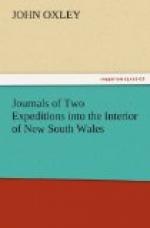August 16.—Quitted the valley (which was named Mary’s Valley) on our eastern course, anxiously hoping that we should reach the river in the course of the day. We had heard last night and this morning the screams of the white cockatoo, which we have always looked upon as a certain sign of approaching water.
The same fine grazing tract of country continued over irregular hills and valleys for about four miles, when ascending a high hill (named Mount Johnston), a little upon our left, we had a very extensive view to the north-east and east. In the former quarter, a beautiful range of hills stretching north and south, bounded at a distance of about eight miles the fine extensive valley before us; under those hills we would fain have found the Macquarie, fancying that we could distinguish the haze arising from water. To the northward, two hills skirted the valley at a distance of six or seven miles, which might be about the medium width of it from north to south, in which quarter a rocky range, clothed with pines and iron-bark, prevented us from seeing to any great distance; to the east and south-east, the same low irregular country appeared, thinly covered with trees and grass.
Desirous of ascertaining if our conjectures were well founded in respect to the river, we altered our course, which was east, to north-east, keeping down the south side of the valley or plain, which we had seen from Mount Johnston. A finer or more fertile country than that we passed through for about four miles and a half cannot be imagined: the soil, a light brown, sandy loam, covered with broom-grass from four to five feet high. After travelling the above distance, we most unexpectedly came upon a stream, which from its high grassy banks and rocky bottom we were obliged to conclude must be the river we were in search of; but so diminished in magnitude that the motion of the water connecting the long chains of reedy ponds, was so slow as scarcely to entitle it to the appellation of a living stream. The whole country from where we quitted the Lachlan to this spot had borne evident marks of long continued drought, and in no part was it more apparent than in the present stream which was so much smaller than it was at Bathurst, even after the great drought in 1815, that after going up it three or four miles, I began to entertain great doubts of its being the same, hoping that it might be one of the channels which must convey the waters from the high ranges of hills, lying nearly midway between the Lachlan and the Macquarie Rivers.




